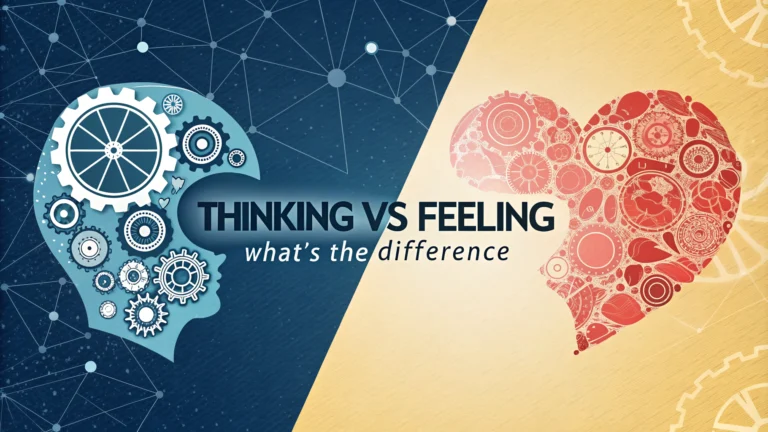The way people make decisions shapes their personal relationships, career choices, and daily interactions. Some rely on logical analysis, while others trust their emotional instincts.
**Thinking** and **feeling** represent two distinct approaches to processing information and making choices. Each style offers unique strengths and potential blind spots that affect how we navigate life’s challenges.
The Science Behind Thinking and Feeling Preferences
- **Cognitive Processing**: How the brain handles information differently
- **Neurological Basis**: Brain regions activated during logical vs. emotional responses
- **Psychological Research**: Key findings from personality studies
Common Characteristics of Thinking-Based Decision Making
- **Objective Analysis**: Focus on facts and data
- **Systematic Approach**: Step-by-step problem solving
- **Logic-Driven**: Emphasis on cause and effect
| Thinking Traits | Associated Behaviors |
|---|---|
| Analytical | Breaking down complex problems |
| Rational | Seeking concrete evidence |
| Objective | Maintaining emotional distance |
Understanding Feeling-Based Decision Making
- **Emotional Intelligence**: Reading social cues and understanding others
- **Value-Based Choices**: Decisions aligned with personal beliefs
- **Intuitive Processing**: Trust in gut feelings and instincts
“The difference between thinking and feeling isn’t about intelligence – it’s about how we naturally process information and make choices.”
The Science of Thinking vs Feeling Decision-Making
Understanding how we make decisions shapes our success in work and relationships. **Thinking** and **feeling** approaches represent distinct neural pathways that influence our choices and behaviors.
Brain Chemistry and Decision Patterns
The prefrontal cortex manages logical analysis while the limbic system processes emotional responses. Research shows both systems work together for optimal decision-making.
Key Brain Areas:
– **Prefrontal Cortex**: Analysis and reasoning
– **Amygdala**: Emotional processing
– **Anterior Cingulate**: Balancing logic and emotion
Developing Emotional Intelligence
Building **self-awareness** helps balance thinking and feeling approaches. Regular reflection on decision patterns reveals personal tendencies.
- Practice identifying emotions before making choices
- Document decisions and their outcomes
- Notice physical sensations during decision-making
Professional Impact and Career Decisions
Different careers favor various decision-making styles. Understanding your natural approach helps with job selection and workplace dynamics.
| Career Field | Preferred Style |
|---|---|
| Engineering | Thinking-dominant |
| Counseling | Feeling-dominant |
| Management | Balanced approach |
Balancing Logic and Intuition
Strong decision-makers combine analytical thinking with emotional intelligence. Practice using both approaches for better outcomes.
“The best decisions come from understanding when to apply logic and when to trust instinct.”
Making Better Personal Choices
Create a personal decision-making framework that honors both thinking and feeling:
- **Pause** before important decisions
- **List** facts and emotional factors
- **Consider** long-term impacts
Building Stronger Relationships
Understanding different decision-making styles improves communication and reduces conflict. Recognize and respect others’ approaches.
Moving Forward with Better Decisions
Effective decision-making requires practice and self-awareness. Start by observing your natural tendencies and deliberately incorporating both thinking and feeling approaches when facing choices.
- **Monitor** your decision patterns
- **Practice** using both styles
- **Evaluate** outcomes regularly
Frequently Asked Questions About Thinking vs Feeling
What’s the core difference between thinking and feeling preferences?
Thinking preferences focus on logical analysis and objective criteria when making decisions, while feeling preferences prioritize personal values and the impact on people. Neither is better – they’re simply different approaches to processing information and making choices.
Are thinkers less emotional than feelers?
No. Thinkers experience emotions just as deeply as feelers. The difference lies in how they prioritize information when making decisions – thinkers tend to set emotions aside temporarily to analyze facts, while feelers actively consider emotional factors.
Can someone be both a thinker and feeler?
Yes. Most people use both thinking and feeling processes. The preference usually shows up as a natural inclination toward one style, but individuals can develop skills in both approaches.
How do thinking vs feeling types handle workplace conflict?
- Thinking types typically focus on finding objective solutions and establishing clear protocols
- Feeling types often prioritize maintaining harmony and considering individual circumstances
What careers are better suited for thinking vs feeling types?
| Thinking Types | Feeling Types |
|---|---|
| Engineering, Analytics, Research | Counseling, Teaching, Healthcare |
How do thinking and feeling types communicate differently?
Thinking types tend to communicate with direct facts and focus on efficiency, while feeling types often use personal references and focus on building rapport.
What are the signs of a thinking preference in decision-making?
- Prioritizing objective criteria
- Seeking logical consistency
- Focusing on cause and effect
- Analyzing pros and cons systematically
How do feeling types approach problem-solving?
Feeling types often consider human factors, seek win-win solutions, and evaluate how decisions align with personal and group values.
Can thinking vs feeling preferences affect relationships?
Yes. Different decision-making styles can create misunderstandings, but awareness of these differences can lead to better communication and mutual understanding.
Are thinking and feeling preferences influenced by gender?
While social conditioning may play a role, thinking and feeling preferences exist across all genders. It’s important to avoid stereotyping based on gender.
How can thinking and feeling types work better together?
Success comes from recognizing the value of both approaches: combining analytical thinking with emotional intelligence often leads to better outcomes than using either approach alone.
Can thinking and feeling preferences change over time?
While core preferences typically remain stable, people can develop their non-preferred style through conscious effort and experience, becoming more balanced in their approach.



















